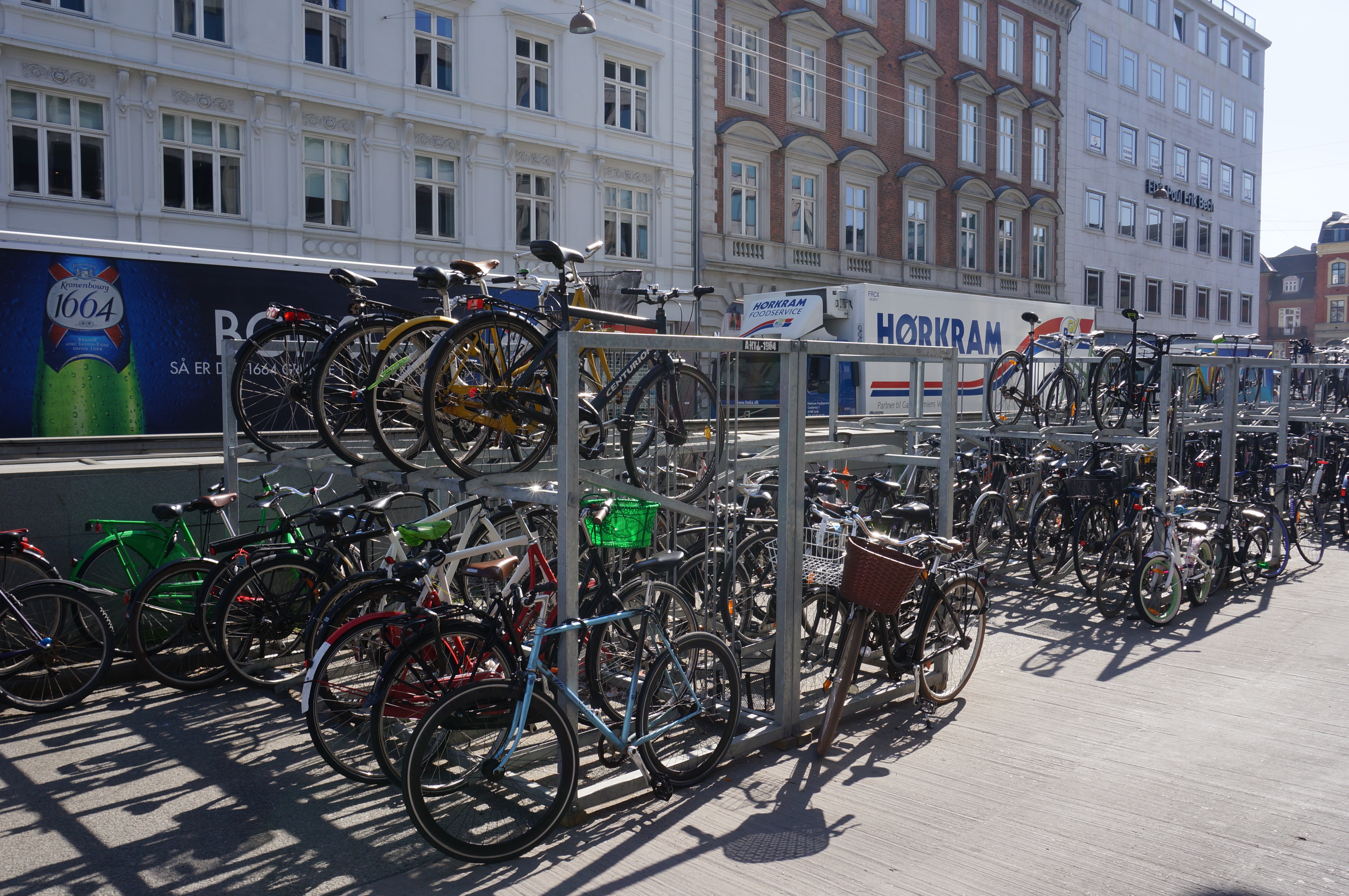Some of my personal happiest times have been when riding a bicycle. Even more fun is riding a bike with a child. Using a bicycle for transportation in the U.S., however, entails a certain amount of risk. Even if there is a dedicated bicycle lane there is nothing to stop a mobile phone-using driver from driving over and hitting you from the left. On right side of the bicycle lane will be a row of parked cars, each one a potential source of a driver opening a door without looking (a common enough accident that the term “being doored” has made its way into our language). For many of the bike trips that I’ve enjoyed I wouldn’t be comfortable taking a child with me on a trailer bike or in a bike seat.
Despite its old cities and old road network, Danes invested heavily in dedicated bicycle lanes. Typically there is a curb separating the bike lane from the cars and one more curb separating the bike lane from the sidewalk. Nobody can hit anybody else without going over a curb, in other words. Rather seldom is it the case that parked cars are next to the bicycle lane. Sometimes the bicycle lane is separated from the road by a curb and grass median. If there are cars parked along the road then an opened door will sway into the grass, not into the paved bike lane.
One sees a lot of children riding in various forms of modified bicycles and tricycles, including one heavy-looking design where two or three kids can ride in a huge basket in front of the bike, with the parent pushing on the pedals from behind. The kids get an awesome view; the adult gets a lot of exercise. Fortunately Denmark is pretty darn flat.
Because a bicycle can be used safely on every segment of almost any trip it becomes much more practical to dispense with car ownership and its $9100 annual bleed (according to AAA). The 24-hour metro, excellent intracity buses, and frequent trains other parts of Denmark complement the utility of bicycles in situations involving miserable weather and/or long distances.
The wild popularity of bikes does have some drawbacks. It can be tough to find a secure parking spot for a bike. There are so many cyclists in the bike lanes in Copenhagen in the summer that bike-bike collisions seem like a realistic fear (though I didn’t see any).
The way that we have things set up in the U.S. contributes to our higher per-capita GDP, but it does not make us better off. For example, if you think that a trip by bicycle will be unsafe due to a lack of bike lanes and take a car, you will burn gasoline, maintenance, and depreciation on that car, thereby boosting the measured GDP compared to if you had used your muscle power (not figured into GDP). If you then sign up for a gym membership and personal training to get rid of the fat that you’ve accumulated during all of these car-instead-of-bike trips, that boosts GDP though at the end of the process you will be no thinner or fitter than if you had biked. If you get hit by a car the GDP can easily be boosted by $25,000. You will buy a new bicycle. The car will need bodywork. You may be concerned about your health and get an MRI done at one of the world’s most expensive MRI clinics. Your MRI will be read by one of the world’s highest paid radiologists. What the radiologist says will be read to you, for a GDP-boosting fee, by one of the world’s highest paid neurologists.



You can buy the “heavy-looking design with a huge basket” from the importer, based in Boston, and here described by a Lexington-based bike blogger: http://lovelybike.blogspot.com/2011/05/3-wheeled-surprise-christiania-cycles.html
There are a pile of videos on Youtube about this subject. Here is a well done and reasonably short one about how cargo-bikes have become the craze now. Take a look at some of these setups – multiple kids and room for a week’s groceries.
Most innovative bicycle creation I’ve seen in years: The biking chef:
https://www.facebook.com/CYKELKOKKEN
For those who don’t have a Facebook account, here’a picture of the chef on the move:
http://www.webmercial.dk/ck_v2/pix/bag.jpg
There are no pedestrian routes through the mountains & across the bay here, even though the distances are only 12 miles. It’s all interstates.
They have nothing on the Dutch, who don’t have bike lanes on highways, but instead have a completely separate bike-only highway system that follows different routes (with grades presumably optimized for bike riders). Of course, it helps that they have a very flat landscape. Twenty mile bike commutes are routine there, not just something sporty people engage in.
Modern electric-assist bicycles equalize terrain – this overweight and sedentary commenter has no problems riding up and down San Francisco’s hills, even though he hasn’t biked in 25 years. I can’t say I care much for the adversarial politics of bike advocacy groups, but they have a point that bicycles are a viable and healthy means of urban transportation, even an enjoyable one in a city like San Francisco.
I want to point out that a new “Cargo” bike is at least $3,500 and it will require some maintenance like tune-ups, tires, brakes, etc. So you are definitely not saving $10,000 an year.